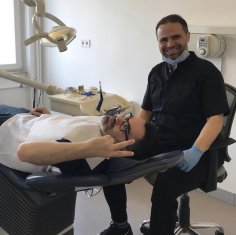Veneers Cost in Turkey
Cost of veneers depend on how many teeth will be covered by veneers, i.e. it depends on the numbers of veneers that will be used. The second criteria that affects cost of veneers is the brand/manufacturer of veneers.
Cost of Veneers for Front Teeth Gaps, Diastema
If there is a space or gap between the front teeth, usually two veneers are used. So the cost of veneers twice the cost of veneers per tooth.
Cost of Front Teeth with Empress & Emax Veneers
900 euro (450 Euro per tooth)
Cost of Front Teeth with Lumineers Veneers
1000 euro (500 Euro per tooth)
Full Set of Veneers Cost
Full set of veneers covers both upper jaw and lower jaw of mouth. So this is also called full-mouth smile design as your smile will change completely because most of teeth that are seen when you smile will be covered by veneers.
Cost of Full Set of Veneers (Smile Design) with Empress & Emax Veneers
7200 euro (450 Euro per tooth, 8 veneers for upper jaw, and 8 veneers for lower jaw)
Cost of Full Set of Veneers (Smile Design) with Lumineers Veneers
8000 euro (500 Euro per tooth, 8 veneers for upper jaw, and 8 veneers for lower jaw)
Please consult us with your pictures, so we can suggest number of teeth that veneers needed to be applied
Upper Jaw Veneers Cost
Although it depends on your smile, sometimes covering the teeth on your upper jaw can make huge difference in your smile. In other words, using veneers only on upper jaw teeth can be enough for some patients. You can think it as cost effective alternative of full set of veneers as upper jaw is the mostly seen part in some patients.
Cost of Upper Jaw Veneers (Smile Design) with Empress & Emax Veneers
3600 euro (450 Euro per tooth, 8 veneers for upper jaw)
Cost of Full Set of Veneers (Smile Design) with Lumineers Veneers
4000 euro (500 Euro per tooth, 8 veneers for upper jaw)
What Are Veneers?
Teeth veneers are one of the most popular ways to attain a perfect smile while covering colored teeth.
Veneers are layer materials placed over a tooth’s enamel that needs to be reshaped or rebuilt, so veneers are usually intended for cosmetic purposes
Veneer layers are used to fix enamel decoloration, fill gaps and repair jagged and chipped teeth. These are both medical and aesthetic purposes that are entailed when choosing a material and system for veneers.
Depending on the used material it can have a 10-year lifespan or even longer
Veneers can be designed to cover all teeth surfaces, wrapping around a tooth so fully covering a tooth.
Porcelain Veneers
Highly resistant porcelain is usually the go to material in top class dentistry. These tend to be thin layers and custom made shells that can be shaped and sized, however, these traditional system has an irreversible character once applied.
Porcelain is characterized for being more resistant to stains than other resin composite materials, it also is one of the most effective mimics to natural teeth when it comes to performance and aesthetics.
Composite Veneers
This system is much simpler and modern than porcelain ones, the material is generally made out of resin and it is typically sculpted in one session according to the patient’s needs. It tends to be a more immediate solution for damaged enamel and decoloration. In some cases, it is used to replace missing parts of a tooth.
Resin is also highly resistant to damage, even more than natural teeth, however, the material tends to wear off in a shorter period than traditionally made porcelain ones.
Prepless Porcelain Veneers
The term “prepless” indicates that veneers shouldn’t require any structural alteration concerning the existing natural teeth. Also, it indicates that the material used may vary as prepless veneers are removable and renewable, unlike solid porcelain veneers.
Application of Traditional Porcelain Veneers
A critical requirement to undergo veneer placement procedures is that the original structure of your teeth should remain so dental technicians may produce a precise digital preview of your smile and temporary placements as well before carrying on with the procedure.
Teeth shouldn’t be severely discolored, at least not so much that the porcelain is unable to cover it.
1st Step:
The doctor takes an impression or X-Ray scans the patients teeth. This helps the dentist forecast a precise and ideal smile for the patient. It also allows to examine whether the patient is or isn’t eligible to wear veneers.
2nd Step:
About 1/2 millimeter of tooth enamel is removed from the patients teeth, this is about the same thickness veneers have. A model of temporaries is made in order to test samples for both comfort and fitness, as well as to test color grading.
3rd Step:
Once the molded restoration models of veneers are made, a dental technician applies composite-resin luting cement on the teeth so veneers can be gently placed. These are temporary placements.
4th Step:
Often, veneers are cured with a special light that activates certain chemicals in the cement that allows teeth and implants to heal and strengthen faster.
5th Step:
Once veneers are placed the dentist should evaluate the bite and final details as well as removing any excess of cement left in the patients mouth.
6th Step:
The patient should check in regularly with a dentist to explore how gums are responding to the presence of the newly placed veneer.
Note that veneers require regular attention including cleanings , examinations and an even a more rigorous hygienic routine. .
Digital Smile Design, i.e. Digital Preview
For decisions as important as whether you should undergo a veneer placement procedure or not, the dentist should be able to preview a digital projection of your future smile.
This is one of the key aspects of the entire veneer instauration process.
Digital preview sessions are made to evaluate materials, shape, and color. The patient is entitled to make the final decision on which type of veneer will be placed as well as the material to be employed.
The importance of joining a dentist highly experienced on cosmetic dentistry when making digital previews lays on finding common ground between a professional suggestion and a pleasing aesthetic for the patient thus designing an ideal smile and teeth.
Traditional Veneers vs Prepless Veneers Comparison
Traditional veneers tend to be more resistant than others and are often used to cover natural teeth for basically a lifetime, they may require more meticulous care and hygienic methods are seen that these are permanent and will be attached with cement.
Also, traditional veneers require to decrease a thin layer of enamel to make way for the new stain-resistant layer on the surface. Porcelain veneers in traditional systems tend to display a more perfected shape in comparison to prepless veneers.
On another hand, prepless veneers are more of an ideal choice for those who fear losing enamel and may want to look in the future for more aesthetic alternatives, this system is reversible and perhaps more immediate than traditional porcelain ones, however, it is not as stain and damage resistant in comparison.
Disadvantages of Porcelain Dental Veneers
Main negative side effects and general cons of veneers in general include:
- Potential need to replace or fix regardless of the material
- Elevated costs depending on the country or region you decide to undergo the procedure in.
- Extra care and hygiene when eating and biting hard surfaces.
- In many cases there is a need for night guards for the veneer when sleeping.
- The process is irreversible even if broken.
- Teeth wont look the same after veneers have been placed.
- It removes a considerable amount of enamel.
Advantages of Porcelain Dental Veneers
- A more aesthetic smile is guaranteed.
- It protects the natural base of teeth and may strengthen while correcting the structure.
- It arranges chipped and wore teeth.
- Fixes discoloration of enamel and replaces it with a more stain resistant surface.
- Permanently fixes the structure of natural teeth while protecting it.
- Higher resistance than natural teeth when biting.
- Various options to choose from when choosing material, thus allowing the patient to choose an ideal tone for his or her smile.
Veneers FAQS
How do i know if i’m eligible for veneers?
You don’t need to have perfect teeth in order to get veneers, in fact your teeth shouldn’t be otherwise there is not much point in getting them.
Clean teeth, meaning no cavities and solid gums, are necessary for the veneers to have a solid foundation to stick with.
To make sure you’re ready for the transformation, your dentist should only make sure to shape your teeth and place them in the right angle before undergoing the veneer treatment. The idea is to keep as much natural teeth as possible, since this procedure aims to be minimally invasive.
Are Veneers Low Maintenance?
Veneers are highly resistant, but they require just as much care as teeth, regular brushing and flossing as usual are key for these to last. It is also recommended a monthly visit to the dentist.
How Long Can a Veneer Last
The duration of a veneer depends not only on the technician that makes them but also the material used for it. Porcelain ones are said to last up to 2 decades if proper care is given to a composite veneer (non porcelain). Ideally these should be made out of a top quality material and for them to last a lifetime with proper care as if they were natural teeth.
Regular visits to the dentist can avoid the loss of entire veneers and even a more affordable reinvention and fixing of a particular one if needed.
What Are Lumineers?
Lumineers are even thinner porcelain veneers (as thin as a contact lens) that cover the enamel alike other types of veneer systems, however, lumineers offer a more aesthetic approach rather than a protective or healthy one for your teeth it is the most requested system in the world due to its natural-looking effect.
Unlike other types of veneers, Lumineers require a rather painless process and are removable with no harm done to the enamel. Lumineers also tackle however chipped and moderately displaced teeth, however, its most remarkable asset is the way it brightens up and fixes teeth gaps.
To be eligible to wear lumineers as a designated veneer system, patients cannot have deteriorated teeth or severe decoloration.
Getting Veneers in TurkeyDental Tourism
There are many affordable options outside of the U.S, and Europe, Turkey offer a top-notch quality service at lower prices that offer veneer implants 50-70% cheaper in comparison to the U.S., U.K. or Europe
Turkey is one of the most notorious dental tourist destinies, known for offering high-quality dentistry services at more affordable prices than other European regions. Prices range the equivalent of € 450 per tooth of veneers.
Istanbul has profited largely from top college graduates (University of Istanbul) that keep fares at accessible prices, earning them bulk work when it comes to veneers, this
also earns them plenty of international clients.





